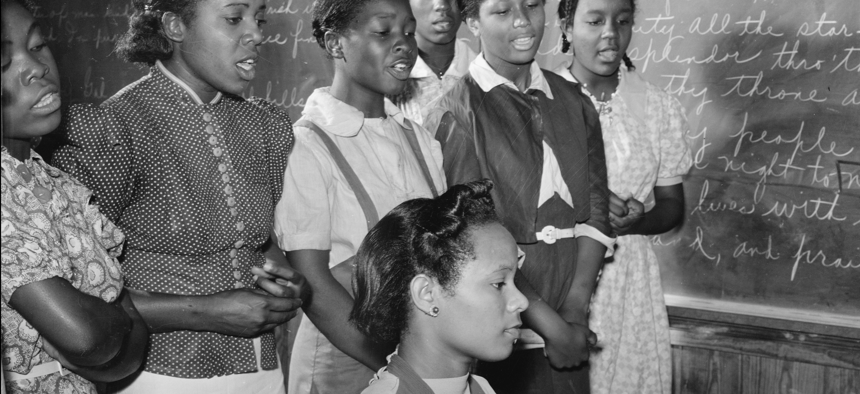Even in Black History Month, Interpreting the Past Can Be a Challenge for Local Governments

Students in a music class at Flint River Farms, Georgia, circa 1939. Gettyimages/Buyenlarge
Inclusiveness and the need to balance priorities are among the issues officials nationwide face.
Last year, the National Park Service awarded Rock Island, Illinois, a $33,500 grant to create a Black history heritage trail highlighting 10 sites of great significance in the city.
Earlier this month, after a heated discussion, the Rock Island City Council voted to return the money.
The problem was that African American residents of Rock Island said they weren’t included in a process that involved city officials and two consultants.
"We feel that the city has acted with total disrespect for the Black community," members of the coalition said earlier this month. "To us, the Black community, this is more than a marker on a tourism trail; it is the stories of our lives, the stories of our ancestors' past and the stories of our children's futures. Because knowing their past will make children stronger, more resilient and build better citizens for the future."
One of the city’s aldermen, Moses Robinson, said he was frustrated that he learned about the grant application from his constituents, rather than city officials. “We are tired of individuals from afar making decisions for our community without including them," he said at the meeting in which the council voted to reject the grant.
Many cities and towns look to Black History Month as an opportunity to honor the contributions of African Americans in their history. In Fairfax County, Virginia, officials are ramping up their Black/African American Experience Project, a joint effort of the county's Board of Supervisors, its public schools, its history commission, and its neighborhood and community services unit. The project has three parts: collecting stories, facilitating school projects and placing new historical markers. Submissions for potential markers are being accepted during February and March.
Nonprofit organizations are leading the way in many of the preservation and storytelling efforts. In Georgia, the Flint River Farms Preservation Society is working to preserve a New Deal-era Black farming community. The organization signed a long-term lease from the local school board for 25 acres of land where the community’s school once stood. They then created the Flint River Farms Community School Heritage Park.
In Colorado, a nonprofit organization called Colorado Preservation, Inc., highlighted sites centered around Black people, indigenous people and people of color in the 25th anniversary edition of its Colorado's Most Endangered Places list.
“As part of a larger national conversation going on around the issues of diversity, equity and inclusion, the preservation community has been more and more attentive to that,” Kim Grant, director of the endangered places program, told Colorado Public Radio recently.
Sometimes, efforts to acknowledge history collide with other priorities. In St. Petersburg, Florida, the original units in the city's first African American housing community, Jordan Park, are slated for the wrecking ball to make way for a new $93 million redevelopment project recently approved by the U.S. Department of Housing and Urban Development. The city is contributing $2 million toward the effort. It’s a bittersweet project for historic preservationists, in which the loss of a piece of history is offset by the creation of hundreds of units of low-income housing.






